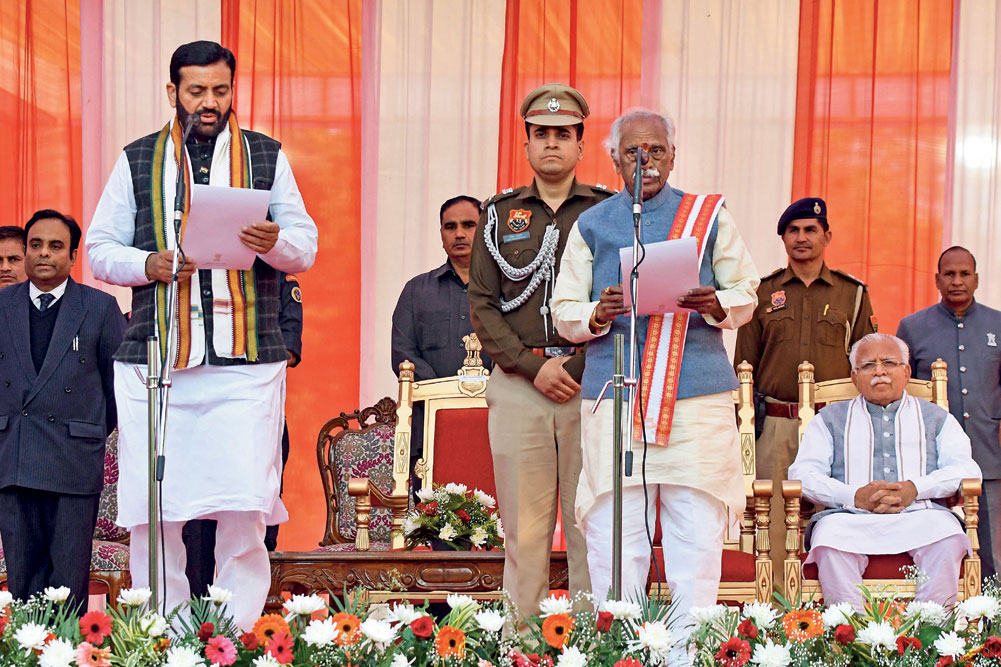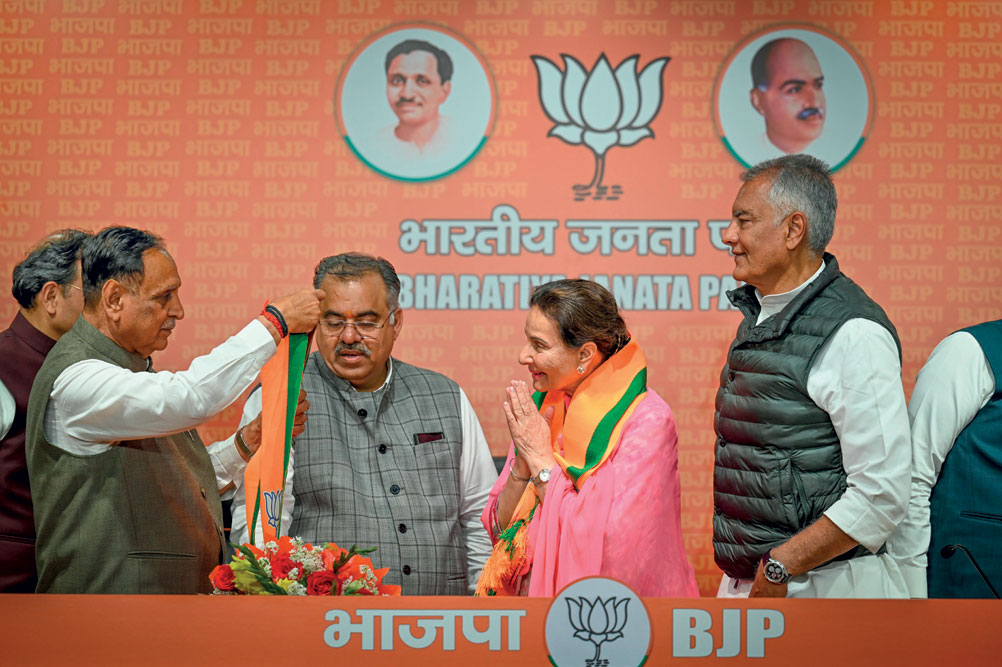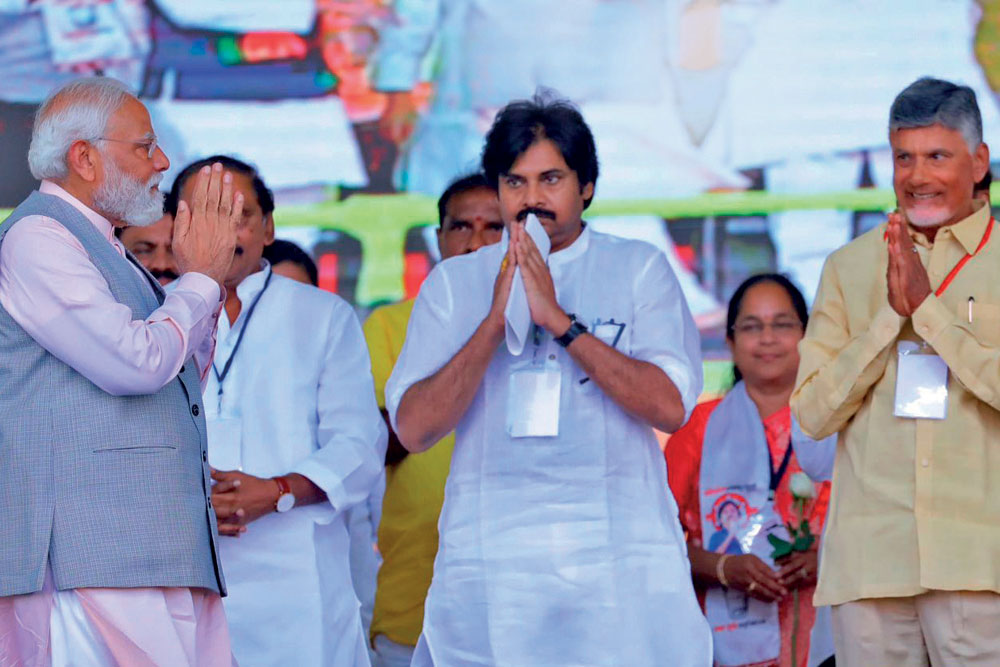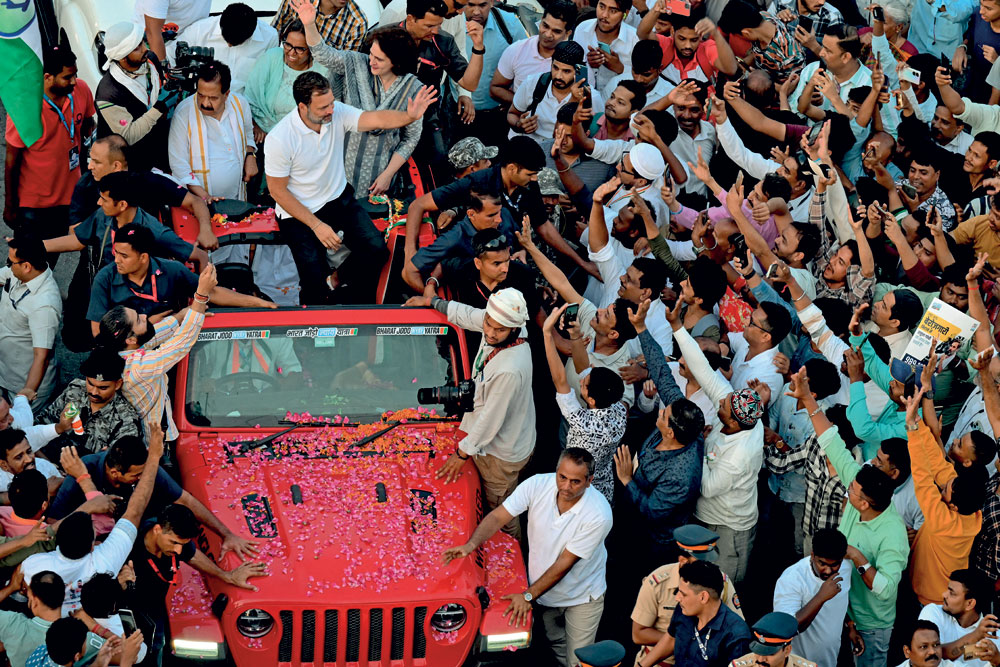The Modi campaign is at full throttle while the Opposition shows no signs of catching up

Prime Minister Narendra Modi on a roadshow in Hyderabad, March 15, 2024
ON THE WINTRY DAY OF DECEMBER 11 LAST YEAR, BHARATIYA Janata Party (BJP) leader and then Haryana Chief Minister Manohar Lal Khattar was sent as an ‘observer’ to Madhya Pradesh to announce the new state chief minister’s name. When he got there, he received a call from BJP headquarters giving him the name of Mohan Yadav. Khattar apparently could not locate Yadav, who was seated in the last row, clueless about what was in store. When Khattar asked Shivraj Singh Chouhan to move the resolution proposing Yadav’s name, the former Madhya Pradesh chief minister requested Yadav to stand up. That was when Khattar saw him, amidst a change of guard that ended his Madhya Pradesh counterpart’s tenure after 16 years.
By then, it is said, Khattar had some inkling as to what he would himself face in Haryana. He did not know when. About three months later, Prime Minister Narendra Modi, during the launch of the Haryana section of the Dwarka Expressway, praised Khattar’s leadership and recalled the days when he used to ride pillion on the latter’s bike “when there were narrow roads in Gurgaon”.
The following day there was a bevy of political activity in Haryana. One event led to another. Before the day ended, the state had a new chief minister. After Khattar held a meeting with his ministers, the entire government resigned. At a meeting of the legislators, central observers Tarun Chugh and Arjun Munda were sent. Even before there was scope for any speculation, Khattar had proposed the name of state BJP president Nayab Singh Saini as his replacement. According to party sources, the script for the leadership change had been drafted around six months ago, but there was uncertainty only over whether it would be carried out before or after the Lok Sabha polls. With state Assembly elections in Haryana due in November, the central leadership was of the view that it was better to face the General Election under new, fresh leadership in the state.
Khattar, like Chouhan, will be contesting the Lok Sabha elections. The transition has been smooth, characteristic of how things work on Modi’s watch.
The same is true of the exercise to recruit new members from other parties who want to jump on the BJP bandwagon, sensing that the future belongs to those who are with the ruling party at the Centre. And BJP keeps receiving a shot in the arm with new influencers and politicians joining them. Recently, in Tamil Nadu where BJP is hoping to do well—and where BJP IT Cell chief Amit Malviya expects space for an alternative to Dravidian parties—it has tied up with the S Ramadoss-led Pattali Makkal Katchi (PMK) which wields enormous influence among the dominant Vanniyar community. BJP also confirmed another alliance in the state with the Amma Makkal Munnetra Kazhagam (AMMK) of TTV Dhinakaran, nephew of the All India Anna Dravida Munnetra Kazhagam’s (AIADMK) former interim general secretary VK Sasikala.

The going seems to be getting easier every passing day, BJP leaders affirm. In Madhya Pradesh, Congress veteran Kamal Nath’s loyalist Syed Zafar, a former Congress spokesperson, has joined BJP. Similarly, in Uttarakhand, Congress’ three-time MLA from Badrinath, Rajendra Singh Bhandari, has joined BJP, shortly after Congress leader Manish Khanduri, son of former Chief Minister BC Khanduri, entered the saffron fold. Likewise in Uttar Pradesh, former Samajwadi Party (SP) MP Devendra Singh Yadav, a close aide of Akhilesh Yadav’s family, has joined BJP close on the heels of two SP MLAs joining the party as well. In Punjab, Patiala MP Preneet Kaur, former Union minister and wife of former Chief Minister Amarinder Singh, joined the party. In Rajasthan, former Congress MLA Ramlal Meghwal and Rashtriya Loktantrik Party (RLP) leader Vikram Singh Gurjar, too, are now in BJP. At the same time, in Tamil Nadu, Anusha Ravi, state secretary of propaganda for the Kamal Haasan-led Makkal Needhi Maiam (MNM), has also joined the saffron party.
With BJP targeting 370 seats, it is counting on capturing uncharted territory besides holding on to its strongholds. Armed with a robust social-media connect, Modi’s charisma, his performance and promise, BJP continues to attract politicians from other parties who wish to be part of the political behemoth that has momentum on its side
In West Bengal, too, the trend is no different. Trinamool Congress (TMC) lawmakers Arjun Singh and Dibyendu Adhikari officially joined BJP recently. Adhikari currently represents the Tamluk Lok Sabha constituency while Arjun Singh is MP for Barrackpore. Again, Congress’ national secretary and co-in-charge of Bihar, Ajay Kapoor, joined BJP on March 13. Padmakar Valvi, Congress leader and former minister, also left his party the same day. The list of new entrants keeps getting longer. Days after she was declared the BJP Lok Sabha candidate from the Union territory (UT) of Dadra and Nagar Haveli, Shiv Sena (Uddhav) MP Kalaben Delkar formally joined the ruling party along with her son Abhinav Delkar. Notably, more than 2,500 workers of different political parties joined BJP in Jorhat in Assam, the majority from Congress. Former Varanasi MP Rajesh Mishra has also quit Congress and joined BJP. In a major blow to TMC’s aspirations, Tapas Roy, their five-time MLA, too has joined BJP.
A similar exodus of leaders, moving from other parties to BJP, is being seen across the country, from Tripura to Gujarat, from Uttarakhand to Kerala. Former Union minister and Congress leader Suresh Pachouri and former MP Gajendra Singh Rajukhedi have joined BJP. Congress legislature party leader in Arunachal Pradesh, Lombo Tayeng, joined the ruling BJP on March 4, ahead of state Assembly polls and the Lok Sabha elections. The sole Congress MP in Jharkhand, Geeta Koda, has also joined the federal coalition leader. Geeta Koda is the wife of former Jharkhand Chief Minister Madhu Koda. Again, Balbir Jakhar, a former Lok Sabha candidate of the Aam Aadmi Party (AAP), has joined BJP along with his supporters. Bahujan Samaj Party (BSP) MP Ritesh Pandey did so too. In Maharashtra, around 55 former Congress MLAs followed in the footsteps of former Chief Minister Ashok Chavan to align with BJP.
A party functionary puts the total number of ‘eminent’ leaders who have joined BJP since January 2024 (as of March 20) at 100.

While these writers were at the BJP office on March 18, there was an announcement that another “eminent personality” or “personalities” were joining the party—a phenomenon that has by now become routine. Party leaders maintain secrecy about the name till the new entrant walks into the media hall to be welcomed by a senior leader with bouquets and garlands. “I am overwhelmed by Modi’s vision for Viksit Bharat and his efforts to uplift the deprived sections. He has given dignity to the poor, farmers and women,” says one such recent entrant, Sangeeta Azad, BSP MP from Lalganj in Uttar Pradesh (UP), reflecting the sentiments of the personalities who have joined BJP recently. She is the third MP to quit BSP, whose chief Mayawati’s inaccessibility within the party and inertia outside, in sharp contrast to her image in the past, has made its leaders uneasy, particularly when Modi is reaching out to all sections, including Dalits.
A Jatav, Azad had defeated BJP’s Neelam Sonkar by over 1,50,000 votes in the reserved constituency in 2019. Interestingly, BJP has again fielded Sonkar from Lalganj, one of the 10 seats BSP had won in the state—out of 80—when it contested the Lok Sabha polls in alliance with SP, which won just five. Azad joined BJP along with her ex-MLA husband, Azad Ari Mardan, who had won the Lalganj Assembly segment on a BSP ticket in 2017. Mardan’s father, Gandhi Azad, was one of the founding members of BSP, seen as a veteran leader in Dalit politics. Thus, her switch to BJP is particularly surprising.

Jharkhand Mukti Morcha (JMM) MLA Sita Soren, the daughter-in-law of party president Shibu Soren, has joined BJP too, alleging that she and her family had been isolated by the party. Soren, sister-in-law of former Chief Minister Hemant Soren, has been a three-time MLA from Jama. Earlier in March, former Congress ministers from Rajasthan Lalchand Kataria, Rajendra Yadav, and Mahendrajeet Singh Malviya joined BJP, three months after their party lost the state Assembly elections. In Assam, where BJP holds nine of the 14 Lok Sabha seats while Congress has three, several Congress leaders, including its former working president Rana Goswami, have joined BJP. The frequency of leaders switching to BJP, cutting across castes and regional lines, has gained momentum since January. In Kerala, Padmaja Venugopal, daughter of veteran Congress leader and former Chief Minister K Karunakaran, joined BJP in early March.
Manohar Lal Khattar, like Shivraj Singh Chouhan, will contest the Lok Sabha polls. The Haryana transition has been smooth, characteristic of how things work on Modi’s watch. The same is true of recruitment from other parties
WITH BJP TARGETING 370 seats, it is counting on capturing uncharted territory besides holding on to its strongholds. Modi is undoubtedly the party’s trump card. As Assam Chief Minister Himanta Biswa Sarma puts it, “The prime minister is the sun and we are all moons around him.” The song in BJP’s advertisement in the raspy voice of a woman, without the accompaniment of any musical instrument, revolves solely around Modi. “Sapne nahi, haqeeqat bunte, tabhi toh sab Modi ko chunte (It’s not dreams but reality that we weave. That’s why everyone chooses Modi),” goes the song played on various audio and audiovisual media, flaunting various welfare schemes, the prime minister’s domestic and foreign policies, the Chandrayaan landing and success of the G20 summit in India.
Modi has been making an all-out outreach to people, especially Hindu devotees, as part of his multipronged efforts to attract the attention of voters to his government’s schemes and priorities in the run-up to the General Election. The idea is to validate the government’s reputation as regards the success of its schemes from what pundits describe as the “horse’s mouth” and use the feedback he gets from these visits—part of the ongoing Viksit Bharat Sankalp Yatra—to ensure consummation for such projects. The aim is to find what officials call “saturation” for these programmes so that nobody else comes up later with claims of having contributed to these initiatives. “I am searching for people who have been left out,” Modi had said on one of his tours. The highlight of these endeavours was Modi’s highly televised surprise visit to Meera Majhi, the 10th-crore beneficiary of Ujjwala scheme, conceived years ago to offer LPG connections to women below the poverty line, in Ayodhya. Modi connected with her family again a few days later, dispatching a letter and gifts.
As Open had reported earlier, Modi has been at this—building goodwill and warming up to the ordinary citizen whenever he could—for a while now, especially on the sidelines of his rallies and political events. These behind-the-scenes interactions over the past several months have been very popular, according to party insiders, in shoring up the confidence of local partymen about poll prospects as well as generating jubilation among the masses about Modi’s governance.

Amit Malviya notes that BJP is committed to taking the message of the prime minister and the party to 65 crore WhatsApp users of the country through its social-media campaign. “While the social-media focus will be on WhatsApp, the party will continue to use other turfs, such as Facebook and X [formerly Twitter], besides expanding its presence in apps such as Instagram and others where younger voters typically hang out,” he tells Open. He says the party is even expecting three-to-six wins from Kerala where it has never won a Lok Sabha seat to date.
BJP is looking at inorganic growth and a realignment of forces, especially in states like Odisha. In Andhra Pradesh, BJP, TDP and JSP have stitched together an alliance promising to bolster the state’s progress. Chandrababu Naidu’s body language at a recent rally was proof of his newfound admiration for Modi
In sharp contrast this time round, opposition parties, especially Congress, seem shrunken in their poll campaign, taking further their dismal showing in the 2019 elections. Losing leaders in droves, these parties are looking more anaemic than ever even as BJP is looking at inorganic growth and a realignment of forces, especially in states like Odisha. In Andhra Pradesh, BJP, the Telugu Desam Party (TDP) of N Chandrababu Naidu, and the Jana Sena Party (JSP) of Pawan Kalyan have stitched together an alliance promising to bolster the state’s progress. “We hope that the alliance will come up to the expectation of the people of Andhra Pradesh with their wholehearted support,” BJP president JP Nadda, Naidu and Kalyan said in a joint statement.
Naidu’s body language at a rally in Amaravati in Andhra Pradesh was proof of the TDP leader’s newfound admiration for Modi. Reiterating that the National Democratic Alliance (NDA) led by BJP will achieve a 400-plus tally on the day of the results on June 4, Naidu gushed, “Modi is Vishwaguru. Modi means development, welfare, and the future. Modi is our pride.” Returning to NDA was an exercise in humility for Naidu. When he snapped ties with the bloc in 2018, in a letter to Naidu, Amit Shah, then BJP president, had said that Naidu’s decision to quit NDA was unilateral. Shah had also rubbished the TDP leader’s claim that BJP was insensitive to the aspirations of the people of Andhra Pradesh. Shah had said the following in his eight-page letter to Naidu: “It is a decision, I am afraid, will be construed as being guided wholly and solely by political considerations instead of development concerns.”
FOR ITS PART, the main opposition Congress’ reconstituted social-media department has not announced any imaginative campaign but has decided to focus on what it called “BJP’s misrule”, a euphemism for anti-Modi propaganda that has repeatedly boomeranged for the Grand Old Party. The party said it will also put the spotlight through its social-media arm on the five “Nyay Guarantees” of Rahul Gandhi that he made on his Bharat Jodo Nyay Yatra. These guarantees cover five sections: the youth, women, workers, farmers, and the marginalised sections. BJP leaders point out that Congress’ guarantees are not original but a “cut and paste” version of Modi’s guarantees. According to the official website of the prime minister, “Modi ki Guarantee means a Viksit Bharat, Ek Shrestha Bharat. It is a guarantee for the development of the youth, empowerment of the women, welfare of the farmers, and all those marginalised and vulnerable who have been ignored for decades.”
The resemblance is inescapable apart from BJP’s being ideologically coherent and Congress’ marked by incoherence.

In addition to its comprehensive campaign, BJP has emphasised its gains, a remarkable one being lifting 25 crore people out of multi-dimensional poverty even as its government provides free foodgrains to 80 crore people via the PM Garib Kalyan Anna Yojana. “This guarantee ensures no one sleeps hungry,” declares an official statement as well as a poll slogan. Since the launch of the Viksit Bharat Sankalp Yatra on November 15, 2023, Modi has routinely interacted with labharthis or beneficiaries of the Union government’s flagship schemes which cut across caste and regional barriers. The record of the government is nothing short of spectacular, if the numbers are anything to go by. Under the PM Awas Yojana, four crore houses have been built during Modi’s tenure. Besides, over 51 crore bank accounts have been opened under the PM Jan Dhan Yojana (PMJDY), with deposits in these accounts totalling over ₹2.08 lakh crore. More than half the account holders are women. The piped potable water scheme, under the Jal Jeevan Mission (JJM), has reached 14 crore households, covering 72 per cent of rural households, according to the Jal Shakti ministry. Like PMJDY and gas connection schemes, JJM is also targeted particularly at changing the lives of women who carry the burden of fetching water from sources far from home.
Congress says it will focus on Rahul Gandhi’s five ‘Nyay guarantees’. BJP points out that his guarantees are a ‘cut and paste’ version of Modi’s guarantees. The resemblance is inescapable apart from BJP’S being coherent and Congress’ being incoherent
BJP leaders say that no state is tough for the party, including Maharashtra. Prem Shukla, BJP national spokesperson, tells Open that Nationalist Congress Party (NCP) leader Sharad Pawar’s political acumen is largely exaggerated. “He has historically used blackmail politics to keep his rivals under control in the past. That kind of operation is no longer possible,” Shukla says, adding that winnability is the criterion in the choice of BJP’s candidates besides stress on development and women’s rights as well as welfare of the poor. “Candidates are changed for non-performance,” he says, speaking of Maharashtra. Other BJP leaders who spoke to Open argue that neither the Shiv Sena nor NCP can blame BJP for the splits in their parties and the fact that the formidable breakaway parties are both aligned with BJP. In Bihar, another state crucial for the elections, BJP looks comfortable, having brought former ally Nitish Kumar back to NDA. In the numerically significant Hindi heartland, especially UP, BJP is expecting to surpass its own “expectations”, says a leader close to the matter. He sees the party peaking across the politically vital region. “We will do extremely well in states we haven’t done well in last time round. We hope to make a big impact in the southern states, which were not our strongholds in the past,” he adds.
Armed with a robust social-media connect, Modi’s charisma, his government’s performance record, and his promise of a better future for Indians as well as national glory, BJP continues to attract politicians from other parties who wish to be part of the political behemoth that has momentum on its side and has torn to shreds any threat of anti-incumbency.